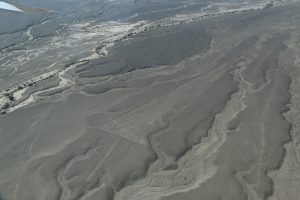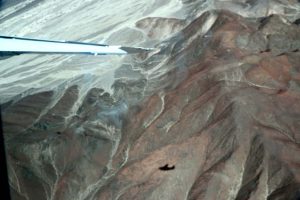
Flying over the Nazca Lines at over 3000 feet is exciting. The plane flies like you’re on a roller coaster.

My friend and I board a small plane that sits 12 people.

The plane dips to the left and then to the right to allow passengers on either side to get a good view of the Nazca Lines.
The Nazca Lines of Peru
The Nazca lines were originally discovered b Peruvian archaeologist Toribis Majia Xesspe in 1927, but the Nazca lines weren’t actually studied until Paul Kososk, who was studying ancient irrigation systems, rediscovered them in 1937. The Nazca Lines which are found in the Nazca Desert in southern Peru between the towns of Nazca and Palpa on the Pamapas de Jumana about 400 km south of Lima, the capital of Peru, are in an area 27 miles long and a 5 miles wide. They were designated as a UNESCO World Heritage Site in 1994.
The lines contain main forms, biomorphs and geoglyphs. The biomorphs are figures of animals and plants. There are over 70, all group together. They are very large, with the largest being over 660 feet across. The biomorphs include images of the spider, the condor, the frigate bird, the monkey, the llama, the tree, and human figures. The geoglpyhs are a series of geometric forms, for example the straight lines, the triangles, the spirals, circles, and trapezoids. The longest is a straight line nine miles long.
Archaeologists believe they were made by brushing away the reddish iron oxide covered rocks and pebbles that cover the Peruvian desert. This allowed the white sand underneath to show through. Because the Nazca area is very dry, windless, and isolated, it has allowed the lines to exist for over 2000 years.
The ancient Nazca people were able to create huge structures that could only be fully appreciated from the air, during a time when manned flight wasn’t known to exist. Some archaeologists believe surveying techniques were used to create the huge pictures, while others believe they couldn’t have been made without some type of manned flight.
The reason why the Nazca lines are famous and visited by people from around the world is because there is so much mystery and many theories on why there were formed. The most widely popular belief is that the lines had religious purpose. The lines were offerings to their gods, who would have been able to see them from the heavens. Other scientists say they are sacred pathways that the ancient Nazca people used during their religious rituals. Then there is the ancient alien theory that states that they are the remains of ancient airfields, used by a technologically advanced civilization. The biomorph of “el astronaut”, according to ancient alien theory, is sited as evidence for this theory.
There are many people who believe this vanished civilization could have been mistaken as the ancient Nazca people’s gods. Without a doubt there are hundreds of theories. The questions usually resolve around their enormous size of the lines. There are over 330 figures, lines and shaped located in an area of 500 sq. kilometers or 190 sq. miles. Among the biogmorphic figures are the famous Nazca condor, hummingbird, whale, spider, dog, and monkey. The largest one is the hummingbird measuring about 300 meters or 900 feet. The monkey is about 135 meter or 445 feet long. With these long lines the question to ask is: was it possible these ancient people had tools and surveying techniques sophisticated enough to create such complex figures that span such large distances? Or is it possible the ancient Nazca people were visited by advanced society over 2000 years ago? The mystery lingers to this day.
Nasca lines link
Here is a video of me and my friend flying over the Nazca lines.
